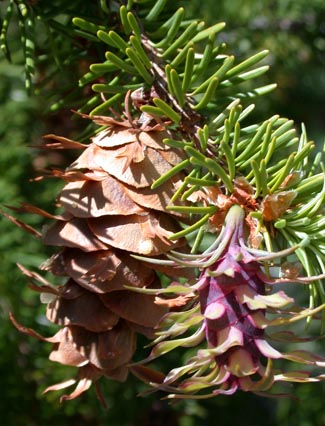Douglas Fir

Common Name(s):
Douglas Fir
Scientific Name:
Pseudotsuga menziesii Franco
Scientific Name Synonyms:
None known
Symbol:
PSME
Description:
Life Span: Perennial
Origin: Native
Season: Evergreen
Growth Characteristics: Douglas fir is a medium-sized evergreen tree with a short pyramidal symmetrical crown at the top of a clear straight trunk. The average size of this tree in Utah is 130 feet tall, and 36 inches in diameter.
Flowers/Inflorescence: The male and female cones are separate, often found on the same twig. Male cones are numerous, very small, and orange-red in color. Female cones, which mature in one growing season, appear at first as purplish or red-green clusters of three-pronged leafy bracts. When mature, the cones are 2 - 4 inches long and brown in color. Woody cone scales are stiff with protruding three-pronged leaf-like bracts that wrap back over the next lower cone scale, these have the appearance of the back legs and tail of a mouse.
Fruits/Seeds: Seeds are small, thin-shelled nuts, about ¼ inch long with terminal wings that averages ¾ inch in length.
Leaves: Needle-like, but flat, flexible, and without sharp tips. They are about 1 inch in length, attached to the twig by short, twisted petioles. The leaves are commonly bluish-green in color. Buds are slender, about ¼ inch long, non-resinous, sharp pointed, and reddish-brown.
Stems: Twigs are slender, orange-brown, and covered with short silky hairs. Bark is variable, being very thin on young trunks to as much as 6 inches thick on old mature trunks. Resin blisters are common on young poles and saplings. The bark surface is smooth on young stems and deeply furrowed between rough gray-brown ridges when mature. The wood is light tan to reddish in color, soft, and fine-grained. It is excellent quality for lumber.
Ecological Adaptions:
Douglas fir is most commonly found on cool, moist, north facing slopes or canyon walls. It is most abundant in nearly pure stands at elevations between 5,000 and 8,000 feet, generally in a belt above ponderosa pine and below Englemann spruce and subalpine fir. It is shade tolerant and often found replacing or "growing up through" aspen stands.
Soils: Grows on a wide variety of soils, but develops best on clay loams, silty clay loams, and silty loams which are deep, moist, and well drained.
Associated Species: Ponderosa pine, lodgepole pine, limber pine, Englemann spruce, Aspen, and blue spruce.
Uses and Management:
Douglas fir is an important and valuable timber tree, accounting for nearly ¼ of the total lumber produced in North America. The wood is used widely as dimensional lumber, timbers, and plywood. The wood is also used for railroad ties, mine timbers, house logs, post and poles, fencing, and firewood. It is used extensively for Christmas trees.
Douglas fir provides cover and habitat for both wildlife and livestock. The seeds are an important food source for birds and small mammals. The needles (leaves) are eaten by blue grouse and spruce grouse.

